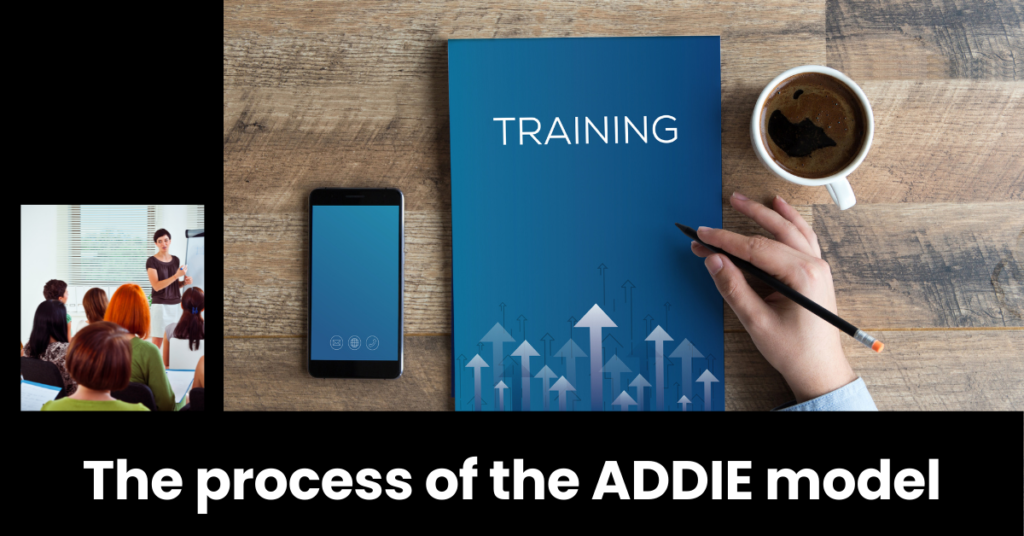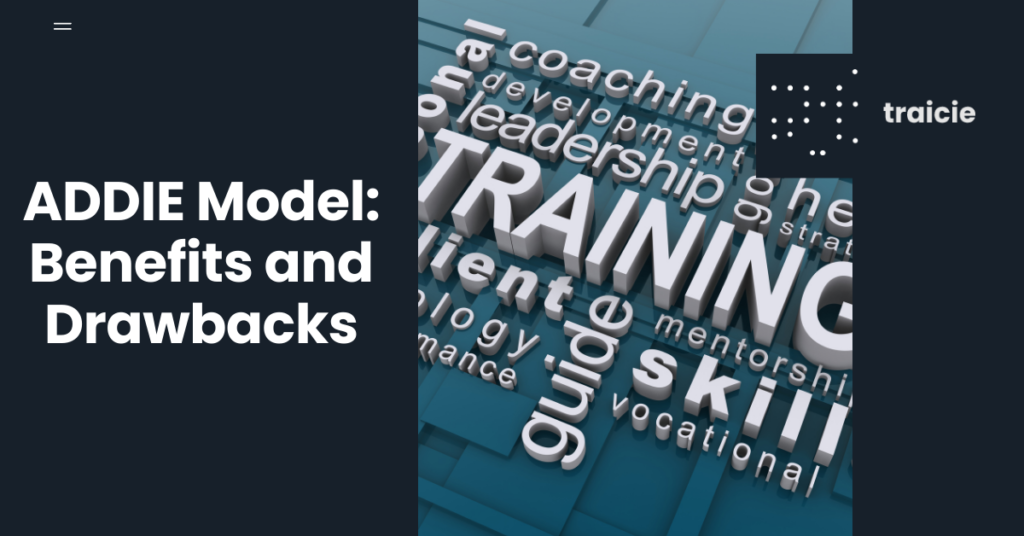The Addie model is an instructional design framework that allows you to organize and to expedite the process of creating the material for your courses. The ADDIE paradigm, developed in the 1970s, is still the most widely used framework for instructional design. Why? – It’s uncomplicated, yet it gets the job done!
In this article, we will examine the numerous processes that involve and provide instructions on how to start utilizing ADDIE right now.
What does the ADDIE Model mean?
The ADDIE is a model for creating lessons that training developers and other teachers use. It follows five steps: analyze, design, build, implement and evaluate.
Since its creation in the 1970s, experts have used the ADDIE Instructional Design (ID) model to plan and design training programs. Even though it has been around for 50 years, ADDIE remains the most used ID model.
Despite its fixed process, the model has become more flexible over time, making it easier to improve and change.
The process of the ADDIE model

Even though the ADDIE process was initially meant to be done linearly, it is now more adaptable and interactive:
Phase 1: Analysis
Before making new teaching materials, it’s essential to look at the current situation. Look at how everything is set up and organized to see where the gaps are that you need to fill. During the analysis phase, you will also fix your instructional targets and goals.
- Use who, what, why, where, when and how to ask good questions, such as: Who is the audience?
- What are their most important traits?
- Why might the people in the audience want to take this training?
- How much do people already know about the topic? Do you see any holes?
- What do we need to get the information to the people?
- Where will this training take place (in person or online)?
- When do you need to finish this project?
After the analysis phase, you should have a strategy for your curriculum or training and know what you will need to do to reach your goal.
Phase 2: Design
In the design phase, we use all the information we gathered in the previous phase to map out the best learning path. This part of the ADDIE model usually takes the longest and the designer needs to pay close attention to every detail.
During this time, you will work on creating essential things like:
- Learning goals
- Subject matter & content
- Lesson plans
- Exercises & assessments
- Media (like videos, pictures, graphics, audio, etc.)
- Feedback
Next, make a storyboard or, if you have time, a working prototype to show other stakeholders how valuable the training is.
After the Design phase, you should have: a plan for the course, a storyboard, a prototype and design elements.
Phase 3: Development
During the development phase, you build the learning experience based on your ideas and plans. At this point, the project and the content have already been decided. If you do the design phase right, you should be able to follow your storyboards and prototypes.
Typical actions to complete in this phase are to make graphics, recording audio and video and, if needed, working with software developers to develop or integrate the required technologies.
| >>> You might also wonder: What is the difference between salary and wage?
Development isn’t just about making learning outcomes; it’s also about testing them. This step of the ADDIE model should go through many changes.
Your whole course or training should be done by the end of the development phase.
Step 4: Implementation
Now that your course is ready, it’s time for learners to try it out.
If you are taking an online course (also “eLearning”), you will usually need to upload your approach to the LMS, which stands for “Learning Management System.” Here you have to include some rules:
- Who can register?
- How much time will students have to complete the course?
- How will you gather responses?
- What is the passing grade for each test?
In this repetitive phase, instructional designers must keep revising, updating or even remaking parts of the training as needed.
After the implementation phase, your curriculum should be live in the LMS and ready for learners to finish.
Phase 5: Evaluation
Now that your course or training has been planned, created and implemented, you need to check to see if it meets your goals.
The evaluation phase has two parts:
- Formative assessments happen at each step of the ADDIE model.
- Summative assessments happen at the end of the program.
In other words, there is always some evaluation during the process. As the analyzed course, the instructional designer must decide if any problems need fixing and if the system is meeting its goals.
After the evaluation phase, you ought to have a better idea of what needs to be changed or improved in the learning experience. This should also help you make better courses and training programs in the future.
| >>> You might also wonder: Review Best Recruitment Automation by AI for Culture fit
How is the ADDIE Model used in reality?

Trello
Using software like Trello is one of the ideal ways to handle the ADDIE model. This project management tool gives you a structured way to keep track of how things move from one stage to the next, and it’s also a great way to keep track of any changes or lessons from each location.
This is very important if a project has more than one instructional designer. You can also use an excellent old-fashioned combination of a whiteboard and post-its!
LMS
With a learning management system (LMS) like LearnUpon, you can easily upload (or create) course content and train your learners. Reporting is one of the most powerful features to measure participation, completion and performance. It will let you keep track of who has signed up and when so that you can stick to the training strategy and schedule.
| >>> You might not know about: How to Hire Based on Soft Skills [Interview Tips]
Let’s look at LMS implementation as an example of how the ADDIE process performs in real life. An LMS is an online hub for creating and running employee training programs. It’s not hard to set up an LMS, but there are many moving parts to keep track of.
• Analyze
Think about how things are now. What is the group doing to meet its training needs right now? What are the priority gaps, and how will using an LMS help close them?
Based on what we’ve talked about, figure out who your LMS is for and what its goals are. For example, one goal could be: “Streamline and automate key training processes, such as hiring and training, reporting and analytics, employee evaluations and exit surveys.”
• Design
Set up your LMS Implementation Action Plan at this stage. Start by getting critical HR and L&D people together while making and running the training.
What will be done with the LMS?
How will the system be updated with new users?
What kinds of tools for creating content and social learning do we need?
If the LMS has gamification tools, how will you use them to get people interested and motivated?
When and to whom will the LMS be released?
• Develop
Here’s where the hard work starts. Set up your LMS tools, characteristics and software integrations with your vendor. Put up content and get ready for people to sign up.
• Implement
Assuming you chose the right LMS vendor, the implementation should go smoothly if you have your ADDIE game plan and have done all the other steps. They take you by the hand and make sure everything goes as planned.
• Evaluate
- Find out what worked and what didn’t from your employees.
- How can the implementation of an LMS be made better?
- Look at the features of the LMS: which were the most common? What didn’t get enough use, and why?
| >>> For an effective Digital Transformation process in your company, learn more about: AI in HR: How does it eliminate hiring bias? Benefits and limitations.
ADDIE Model: Benefits and Drawbacks

The ADDIE model has both good and bad things about it. Think about the following pros and cons when deciding if ADDIE is the suitable model for your instructional design projects.
Benefits
- Ease of use: Addie is an excellent method to get started with instructional design, and it also works well with other ID models if you want to use them.
- Well-organized: ADDIE is made linearly, but it is usually used as a loop (i.e., repeated and iterated). This organized direction can help ID teams stay on track.
- Flexibility and adaptability: ADDIE is structured but also very flexible, so teams can go back and change things as they go. It’s also beneficial because it can be used for learning.
Drawbacks
- Time consuming: Teams often need to move quickly when making a new course or training. The ADDIE model covers much ground, but it takes a while to go through it.
- Linear: ADDIE’s first plan was to be linear. Even though repeating steps and starting the process over can turn into a cycle, the whole model can be hurt if one phase has problems.
- Presumptive: The ADDIE model assumes that instructional designers already know what the learner needs, which isn’t always the case.
In summary
What makes the ADDIE learning model so appealing is how simple and easy it is to understand. It is an organizational process based on learning goals that can be measured and a driver of good design. ADDIE is worth it if you want to make and run a successful training program using a method that is easy to follow and proven to work.
Do you know that traicie’s tools can help C-level or Chief Executives in obtaining strategic, operational value in the recruiting process:
- Cost of a job board- Reduce annual spending on job boards
- Cost of HR tools – Reduce the cost of surveys and assessment tools
- Recruitment costs – Reduce selection costs
- Internal mobility – Fill more skilled jobs with internal staff
- Time to hire – Reduce the number of days a role goes unfilled
- Salary costs – Reduce overall salary costs
- Attrition – Reduce the rate of turnover
- Recruitment cost – Reduce the general recruitment cost